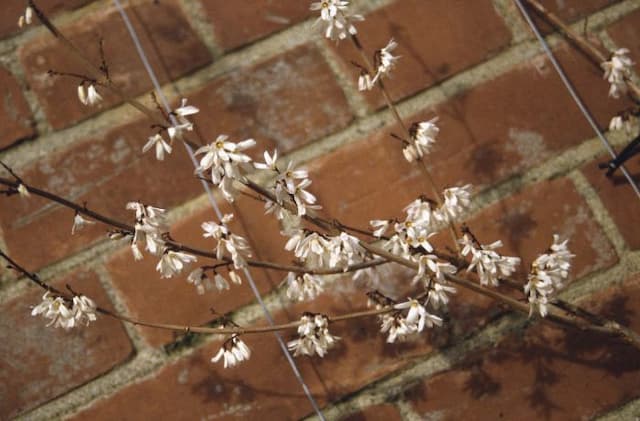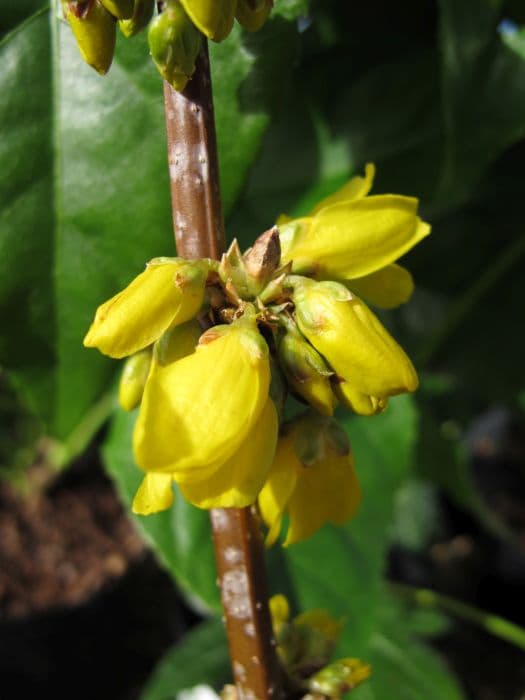South African Jasmine Jasminum angulare

ABOUT
Jasminum angulare, commonly known as South African jasmine or wild jasmine, is a flowering plant that is appreciated for its aesthetic appeal and fragrant flowers. This evergreen climber boasts a sturdy but graceful appearance, with shiny, dark green leaves that provide a lush backdrop for its striking blooms. The leaves are usually compound, consisting of three small, oval to lance-shaped leaflets. The most captivating feature of South African jasmine is its delicate, star-shaped flowers. These blossoms are typically pure white, which contrast beautifully against the deep green foliage. The flowers emerge from tubular buds, unfurling into a five-petaled star that can attract various pollinators. Each of these dainty flowers possesses a sweet, enticing scent, which is particularly strong during the evening and at night, making it a favorite among nocturnal pollinators and a popular choice for planting near sitting areas where people can enjoy the fragrance. South African jasmine tends to flower from late spring through to fall, with some variation depending on the local climate and growing conditions. The overall form of the plant can be somewhat sprawling, with long, arching stems that make it well suited for training on trellises, fences, or other support structures, allowing it to add vertical interest to gardens or landscapes. The plant can also be pruned to maintain a more compact shape, which makes it versatile for various gardening applications. Despite the omission of its size, this jasmine variety remains a charming addition to any garden with its aromatic blossoms and year-round foliage.
About this plant
 Names
NamesSynonyms
South African Jasmine, Wild Jasmine
Common names
Jasminum angulare var. angulare.
 Toxicity
ToxicityTo humans
South African jasmine (Jasminum angulare) is not commonly known for being toxic to humans. There is limited documentation on severe toxicity or poisoning resulting from ingesting parts of this plant. Therefore, while it's always prudent to avoid eating ornamental plants due to potential unknown risks, South African jasmine does not typically pose a significant known threat of poisoning to humans.
To pets
South African jasmine is also not widely recognized as a toxic plant for pets. It does not appear on common lists of plants that are known to be poisonous to dogs, cats, or other domestic animals. Nevertheless, it is generally advised to prevent pets from consuming any non-food plants, as they can cause gastrointestinal upset or other non-toxicity related issues. If a pet does consume South African jasmine and exhibits signs of distress, consulting with a veterinarian is recommended.
 Characteristics
CharacteristicsLife cycle
Perennials
Foliage type
Evergreen
Color of leaves
Green
Flower color
White
Height
8-10 feet (2.4-3 meters)
Spread
5-10 feet (1.5-3 meters)
Plant type
Shrub
Hardiness zones
9
Native area
South Africa
Benefits
 General Benefits
General Benefits- Aesthetic Appeal: Jasminum angulare, commonly known as South African Jasmine, offers delicate white flowers that enhance the visual appeal of gardens.
- Fragrance: The plant is well-known for its sweet and pleasant aroma which can be enjoyed when planted in close proximity to windows or outdoor seating areas.
- Attracts Wildlife: The blossoms of South African Jasmine attract a variety of pollinators, including bees and butterflies, promoting biodiversity.
- Shade Tolerance: South African Jasmine can thrive in partially shaded environments, making it suitable for planting under trees or in areas that do not receive full sunlight.
- Growth Habit: It has a climbing habit which allows it to be used for covering walls, fences, and trellises, offering an element of privacy and vertical interest in landscape design.
- Low Maintenance: South African Jasmine generally requires minimal care once established, making it a convenient choice for gardeners with limited time.
- Drought Tolerance: Once established, it is fairly drought-resistant, which is beneficial in areas with water restrictions or low rainfall.
- Year-Round Interest: With its evergreen foliage, this plant provides year-round greenery and interest even when not in bloom.
 Medical Properties
Medical Properties- This plant is not used for medical purposes
 Air-purifying Qualities
Air-purifying QualitiesThis plant is not specifically known for air purifying qualities.
 Other Uses
Other Uses- Perfume Industry: South African jasmine's fragrance is often extracted to create perfumes and scented oils.
- Aromatherapy: The essential oil derived from the flowers can be used in aromatherapy for its calming and relaxing properties.
- Cultural Significance: In certain cultures, the flowers of this plant are used in ceremonial garlands or as decorations at weddings and festivals.
- Garden Landscaping: Because of its attractive white flowers and vining nature, it is used extensively in garden landscaping as a cover for fences or walls.
- Bee Attraction: The flowers are known to attract bees, making the plant a good addition to support local bee populations and pollination in gardens.
- Butterfly Garden: The plant can be part of butterfly gardens as it serves as an attractant for butterflies and other pollinators.
- Natural Dyes: The flowers or leaves can sometimes be used to create natural dyes for fabric or artwork.
- Hair Accessories: In some regions, fresh flowers may be woven into a woman's hair as a natural and fragrant accessory.
- Culinary Use: Although not common, the flowers can be used as an edible decoration for desserts or in some cases, infused to create jasmine-flavored tea.
- Photography: The aesthetic appeal of South African jasmine makes it a popular subject for garden and nature photographers.
Interesting Facts
 Feng Shui
Feng ShuiThe South African Jasmine is not used in Feng Shui practice.
 Zodiac Sign Compitability
Zodiac Sign CompitabilityThe South African Jasmine is not used in astrology practice.
 Plant Symbolism
Plant Symbolism- Love: Jasmine flowers, including Jasminum angulare, are often associated with love and romance, symbolizing deep affection and emotional warmth.
- Beauty: The delicate white blossoms represent beauty and grace, highlighting a person's inner and outer attractiveness.
- Purity: The pristine color and fragrant scent lend themselves to symbolic meanings of purity and innocence.
- Sensuality: The intoxicating aroma of Jasmine is often linked with sensuality and intimacy, making it a common element in perfumes.
- Good Fortune: In some cultures, Jasmine is believed to bring luck and positive energy, often used in ceremonies for prosperity.
 Water
WaterSouth African Jasmine prefers to be watered when the top inch of soil becomes dry to the touch. This typically means watering it thoroughly once a week, but frequency can vary depending on the environmental conditions such as temperature and humidity. When you water, do so until water runs out of the drainage holes to ensure the roots are evenly moistened. South African Jasmine does best with about one to two gallons of water during each watering session, depending on the size of the plant and pot. During the winter months, water less frequently, allowing the soil to dry out a bit more between waterings.
 Light
LightSouth African Jasmine thrives in bright, indirect light. It's ideal to place it in a spot where it gets plenty of light but is shielded from the harsh, direct afternoon sun, which can scorch the leaves. A south or west-facing window with a sheer curtain provides the perfect balance of light for the plant.
 Temperature
TemperatureSouth African Jasmine prefers temperatures between 60 and 75 degrees Fahrenheit, which is typical of an indoor environment. It can tolerate minimum temperatures down to about 50 degrees Fahrenheit but should be protected from drafts and sudden temperature changes. The plant can handle short periods of higher temperatures but prolonged exposure can be harmful.
 Pruning
PruningPruning South African Jasmine helps to encourage bushier growth and maintain a pleasant shape. Prune lightly after the plant finishes flowering, usually in late summer or early fall, removing any dead or overgrown branches. Pruning can be done annually or biennially, according to the plant's growth and your desired shape.
 Cleaning
CleaningAs needed
 Soil
SoilSouth African Jasmine thrives in well-draining, loamy soil with a pH between 6.0 and 7.5. For the best soil mix, combine two parts loam, one part peat, and one part sand to ensure proper drainage and aeration.
 Repotting
RepottingSouth African Jasmine should be repotted every two to three years or when the plant becomes root-bound. Early spring, just before the growth season, is the ideal time for repotting.
 Humidity & Misting
Humidity & MistingSouth African Jasmine prefers moderate to high humidity levels, ideally between 40-60%. Consistent humidity is beneficial for lush growth and vibrant blooms.
 Suitable locations
Suitable locationsIndoor
Place in bright, indirect light and keep soil moist.
Outdoor
Plant in partial shade, shelter from cold, keep well-watered.
Hardiness zone
9-11 USDA
 Life cycle
Life cycleSouth African Jasmine (Jasminum angulare) begins its life cycle as a seed, germinating in well-draining soil and warm conditions to develop a primary root and shoot system. As a seedling, it establishes true leaves and begins photosynthesis, growing into a young plant with a shrubby form. During its growth phase, South African Jasmine develops woody stems and multiple branches, covered with dark green, pinnate leaves. It reaches maturity and starts flowering, producing fragrant, white, star-shaped flowers usually during spring and summer. After pollination, typically by insects attracted to its scent, it produces berry-like seeds that are dispersed by various agents, including birds. The seeds then mark the beginning of a new generation if they find a suitable environment to germinate and grow.
 Propogation
PropogationPropogation time
Spring to Summer
South African Jasmine, scientifically known as Jasminum angulare, is often propagated through semi-ripe stem cuttings. The most suitable time for this method is during late spring through summer when the plant's growth is vigorous. Cuttings should be about 4 to 6 inches (10 to 15 centimeters) long, taken from healthy, non-flowering stems. Strip the lower leaves, dip the cut end into rooting hormone powder to encourage root development, and then insert the cutting into a well-draining soil mix. Keep the soil consistently moist but not waterlogged and place the pot in a warm area with bright, indirect light. Rooting typically occurs within a few weeks, after which the new plants can be gradually acclimated to normal conditions and eventually transplanted outdoors or into larger pots.









